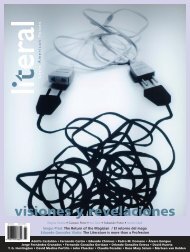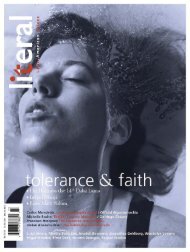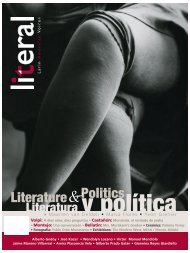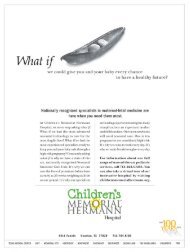Giobany Arévalo > Gabriela Torres Olivares >Anuar Jalife - Literal
Giobany Arévalo > Gabriela Torres Olivares >Anuar Jalife - Literal
Giobany Arévalo > Gabriela Torres Olivares >Anuar Jalife - Literal
Create successful ePaper yourself
Turn your PDF publications into a flip-book with our unique Google optimized e-Paper software.
LIBROS BOOKS CD RECORDS<br />
THE WORDS FLOW<br />
John Pluecker<br />
César Aira,<br />
Ghost,<br />
New Directions,<br />
New York, 2008.<br />
Translated<br />
by Chris Andrews<br />
From the fi rst minute I held César Aira’s<br />
Ghosts in my hand, I was pleased. The cover<br />
with its soft shadow darkening from bottom<br />
to top. Its mysterious raised dot of white at<br />
the center and raised lettering at the base.<br />
The sparse design of the book drew me in.<br />
Also its size. Its smallness. The fi rst few pages<br />
are engrossing: Aira quickly drops the reader<br />
into a whirlwind of activity in a condominium<br />
tower under construction in Buenos Aires.;<br />
builders, engineers, decorators, architects<br />
busily prepare the tower for its future residents,<br />
who coincidentally are touring their<br />
soon-to-be home that very day. Their children<br />
run excitedly through the shell of the<br />
building. After some time with these busy,<br />
frantic, wealthy people, they leave and we<br />
are left in the building with a Chilean family,<br />
the family of the watchman who lives at<br />
the site. Their children continue to play: the<br />
thought of children playing on these unembellished<br />
concrete fl oors, these vast planes<br />
with no walls to contain them produces a<br />
tension that lasts until the fi nal sentence of<br />
the book. What prevents them from falling?<br />
We enter the fi nal day of the year with<br />
the Viñas family, shopping, playing, work-<br />
ing, napping, eating, drinking. All the while,<br />
dusty, naked male ghosts wander though<br />
the building, fl oating around aimlessly, unworthy<br />
of note or explanation. The joy of<br />
reading this book (and Aira in general) is his<br />
uncanny ability to weave anecdotal (often bizarre)<br />
twists of story-telling into a whole that<br />
is resolutely experimental and destabilizing.<br />
The careful prose of the book speeds along<br />
gently with nary a wasted word or cliché.<br />
The prose feels limber, fl exible; it bends and<br />
stretches. The words are never heavy or plodding.<br />
(No doubt, the masterful translation of<br />
Bolaño translator Chris Andrews is to thank<br />
here.) The words fl ow, refl ecting la huida hacia<br />
adelante, the fl ight forward, that Aira has<br />
mentioned in interviews. Aira is iconoclastic.<br />
In interviews, he has insisted he does not<br />
edit or plan the structure of his novels before<br />
writing. He is more interested in the process<br />
of writing, the commitment to artistic creation<br />
than a fi nal product. He writes a page<br />
a day and ends up published two or three<br />
of these small novels each year, mainly with<br />
small presses in Argentina.<br />
In the midst of this continuous fl ow of<br />
story, Aira includes a number of long philosophical,<br />
sociological and architectural refl<br />
ections on life, man, art, building and form<br />
narrated in the voice of a teenage girl, Patri<br />
Viñas. Aira delights in what is seemingly<br />
(though actually not) tangential; he clearly<br />
loves the refl ective mode. He leisurely explores<br />
theory and the deep complexity of artmaking<br />
with a language and a complexity of<br />
thought seemingly foreign to this teenager<br />
who becomes the axis for the second half of<br />
the book. In one of these unconstrained soliloquies<br />
in the voice of Patri, Aira refl ects on<br />
the wisdom of the seemingly ignorant, the<br />
philosophical depth of the apparently uneducated:<br />
“A person might have never thought<br />
at all, might have lived as a quivering bundle<br />
of futile momentary passions, and yet at any<br />
moment, just like that, ideas as subtle as any<br />
that have occurred to the great philosophers<br />
might dawn on him or her.” Aira is obsessed<br />
with these moments and with writing these<br />
moments in a nimble prose that moves<br />
continuously on from one scene, from one<br />
thought to the next.<br />
The building where the Viñas family<br />
lives is empty, a shell. The structure of the<br />
novel (and its actual design as a book) seems<br />
similarly shell-like–well designed, masterfully<br />
constructed, perplexing. The structure with<br />
54 LITERAL. LATIN AMERICAN VOICES FALL, 2009<br />
no artifi cial boundaries or great adornment<br />
is actually more exciting, more loaded with<br />
potential than something fi nished, fully decorated<br />
and fl eshed out. These half-fi nished<br />
structures become spaces of play and diversion,<br />
eliciting and allowing a sense of freedom<br />
a fi nished structure could never provide.<br />
In the end, this unfi nished world inhabited by<br />
an immigrant family and a legion of ghosts<br />
becomes a stage for a singular tragedy.<br />
Who are these naked male ghosts? Who is<br />
this happy family celebrating New Year’s Eve,<br />
unconcerned with the ghosts around them?<br />
Who is Patri and why is she increasingly obsessed<br />
with these ghosts? Aira never answers<br />
these questions. He is not interested in<br />
explaining. Hopefully though, at the book’s<br />
end, you, like me, will be so entranced by the<br />
story that this freedom, this unfi nishedness,<br />
this lack of fi xity only adds to its sad joy.<br />
EL TIEMPO DE UNA ILUSIÓN<br />
Pedro M. Domene<br />
Félix J. Palma,<br />
El mapa del tiempo,<br />
Algaida, Sevilla, 2008.<br />
La distinción entre pasado, presente y futuro<br />
–escribió Albert Einstein– es una ilusión, aunque<br />
se trata de una ilusión muy persistente,<br />
tanto que la literatura universal se ha empleado<br />
a fondo para desarrollar argumentos, tan<br />
hermosos que han pervivido en el tiempo,<br />
han cautivado a los lectores del pasado, divierten<br />
en el presente y tal vez ocurra lo mismo<br />
en el futuro. Un novela como El mapa del<br />
tiempo (2009), de Félix J. Palma (Sanlúcar de<br />
Barrameda, Cádiz, 1968), reconocido como<br />
uno de los jóvenes escritores españoles más<br />
originales, ofrece un singular viaje al Londres<br />
de fi nales del siglo XIX, ese lugar donde parecía<br />
que todo iba a ser posible y el desarrollo<br />
científi co no tendría límites. Quizá por eso,<br />
un escritor como H.G. Wells conseguía con<br />
sus cuentos fantásticos y con su novela La






